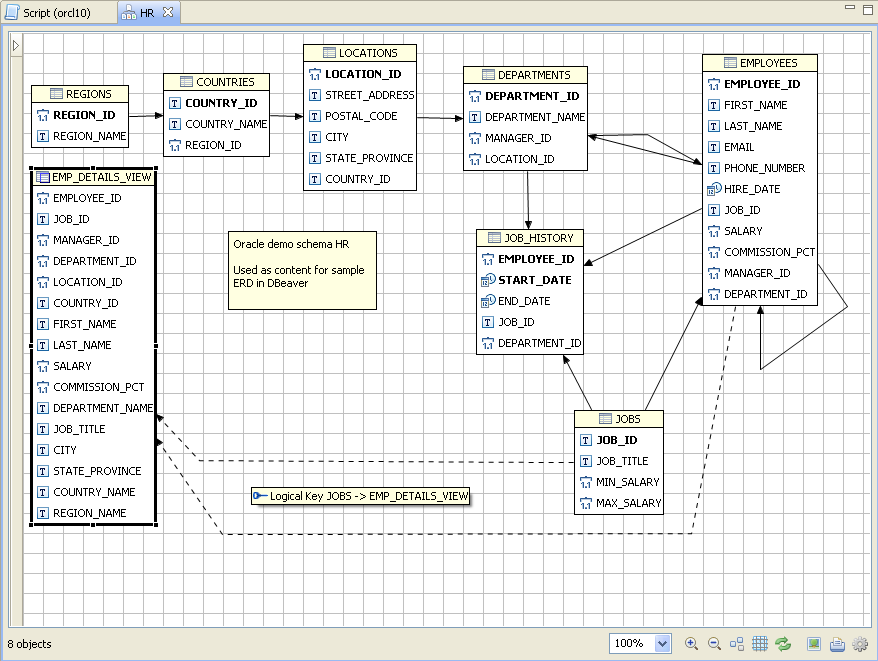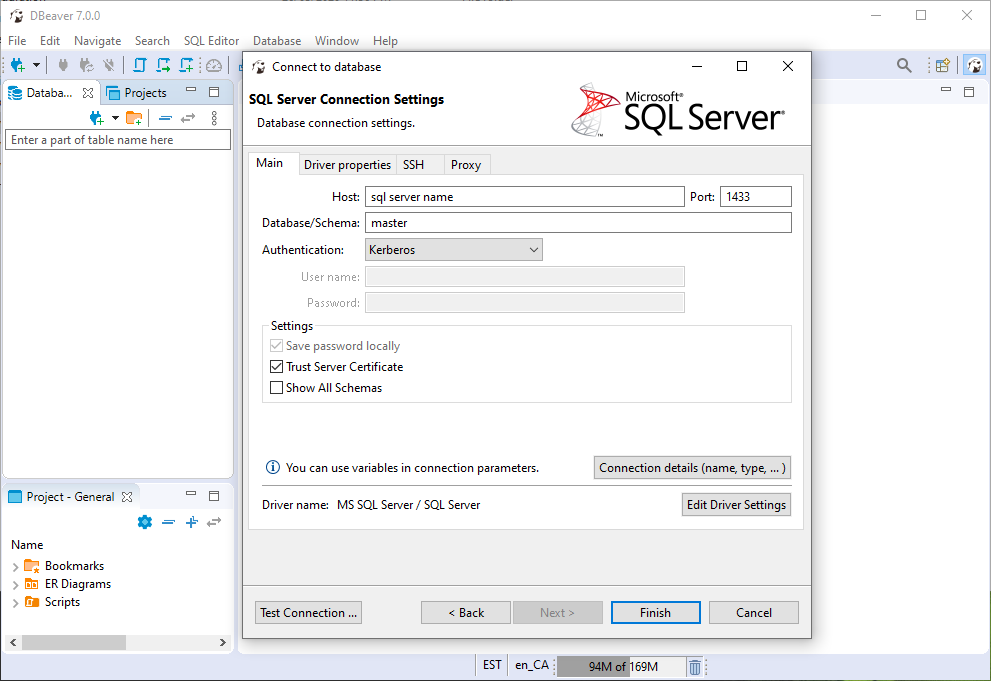Sql Dbeaver
The CData JDBC Driver for SQL Server implements JDBC standards that enable third-party tools to interoperate, from wizards in IDEs to business intelligence tools. This article shows how to connect to SQL Server data with wizards in DBeaver and browse data in the DBeaver GUI.
Free multi-platform database tool for developers, database administrators, analysts and all people who need to work with databases. Supports all popular databases: MySQL, PostgreSQL, SQLite, Oracle, DB2, SQL Server, Sybase, MS Access, Teradata, Firebird, Apache Hive, Phoenix, Presto, etc. DBeaver is a SQL Client which is helpful in querying data and its analysis. It is loaded with many generic JDBC drivers for connecting to popular databases. For others, we can add driver separately and establish a connection. Following are the steps to connect to Redshift data from DBeaver. Free multi-platform database tool for developers, database administrators, analysts and all people who need to work with databases. Supports all popular databases: MySQL, PostgreSQL, SQLite, Oracle, DB2, SQL Server, Sybase, MS Access, Teradata, Firebird, Apache Hive, Phoenix, Presto, etc.
Create a JDBC Data Source for SQL Server Data
Follow the steps below to load the driver JAR in DBeaver.
- Open the DBeaver application and, in the Databases menu, select the Driver Manager option. Click New to open the Create New Driver form.
- In the Driver Name box, enter a user-friendly name for the driver.
- To add the .jar, click Add File.
- In the create new driver dialog that appears, select the cdata.jdbc.sql.jar file, located in the lib subfolder of the installation directory.
- Click the Find Class button and select the SQLDriver class from the results. This will automatically fill the Class Name field at the top of the form. The class name for the driver is cdata.jdbc.sql.SQLDriver.
- Add jdbc:sql: in the URL Template field.
Create a Connection to SQL Server Data
Follow the steps below to add credentials and other required connection properties.
- In the Databases menu, click New Connection.
- In the Create new connection wizard that results, select the driver.
- On the next page of the wizard, click the driver properties tab.
Enter values for authentication credentials and other properties required to connect to SQL Server.
Connecting to Microsoft SQL Server
Connect to Microsoft SQL Server using the following properties:
- Server: The name of the server running SQL Server.
- User: The username provided for authentication with SQL Server.
- Password: The password associated with the authenticating user.
- Database: The name of the SQL Server database.
Connecting to Azure SQL Server and Azure Data Warehouse
You can authenticate to Azure SQL Server or Azure Data Warehouse by setting the following connection properties:
- Server: The server running Azure. You can find this by logging into the Azure portal and navigating to 'SQL databases' (or 'SQL data warehouses') -> 'Select your database' -> 'Overview' -> 'Server name.'
- User: The name of the user authenticating to Azure.
- Password: The password associated with the authenticating user.
- Database: The name of the database, as seen in the Azure portal on the SQL databases (or SQL warehouses) page.
Built-in Connection String Designer
For assistance in constructing the JDBC URL, use the connection string designer built into the SQL Server JDBC Driver. Either double-click the JAR file or execute the jar file from the command-line.
java -jar cdata.jdbc.sql.jarFill in the connection properties and copy the connection string to the clipboard.
Below is a typical connection string:
jdbc:sql:User=myUser;Password=myPassword;Database=NorthWind;Server=myServer;Port=1433;

Query SQL Server Data
You can now query information from the tables exposed by the connection: Right-click a Table and then click Edit Table. The data is available on the Data tab.
| Original author(s) | Serge Rider |
|---|---|
| Developer(s) | Open-source community |
| Initial release | 2010; 11 years ago |
| Stable release | |
| Repository | |
| Operating system | Cross-platform |
| Available in | Multilingual |
| Type | |
| License | Apache license |
| Website | dbeaver.io |
DBeaver is a SQL client software application and a database administration tool. For relational databases it uses the JDBCapplication programming interface (API) to interact with databases via a JDBC driver. For other databases (NoSQL) it uses proprietary database drivers. It provides an editor that supports code completion and syntax highlighting. It provides a plug-in architecture (based on the Eclipse plugins architecture) that allows users to modify much of the application's behavior to provide database-specific functionality or features that are database-independent. This is a desktop application written in Java and based on Eclipse platform.
The community edition (CE) of DBeaver is a free and open source software that is distributed under the Apache License. A closed-source enterprise edition of DBeaver is distributed under a commercial license.
History[edit]
DBeaver was started in 2010 as a hobby project. It was supposed to be free and open-source with a good-looking and convenient UI and to include frequently used features for database developers.The first official release was in 2011 on Freecode.[1]It quickly became a popular tool in the open-source community.[2][3]
In the same year, the official web site was founded and the community support forum (now moved to GitHub) was created.[4]In 2012 an Eclipse plugin version was released - since then DBeaver has become one of the most popular database extensions for Eclipse (top 50-60 among all Eclipse extensions).[5]
Shortly after, various software vendors started to integrate with DBeaver (mostly as an extensions to their proprietary Eclipse RCP products: Zend Studio,[6] NXTware,[7] DeltaDNA,[8] etc.).

In 2014 the Enterprise Edition (EE) version was released. The EE version is based on CE but also provides support of NoSQL/BigData databases (Cassandra, MongoDB and Redis) and includes a few additional Eclipse plugins.
In 2015 DBeaver source code/community has moved to GitHub.[9]

In 2017 DBeaver CE was relicensed under Apache License (starting from version 4.x).[10]
In July 2017 DBeaver EE version became commercial in order to support CE version.
Supported platforms and languages[edit]
DBeaver is a cross-platform tool and works on platforms which are supported by Eclipse (Windows, Linux, MacOS X, Solaris). DBeaver is available in English, Chinese, Russian, Italian, and German.
Versions[edit]
Full list of all released versions[11]
Community Edition[edit]
Community Edition (CE) is the initial version of DBeaver. It was released in 2010 and became open-source (GPL) in 2011.CE version includes extended support of the following databases:
- MySQL and MariaDB
- Any other database which has JDBC or ODBC driver.
Besides relational databases, CE version supports WMI driver (Windows Management Instrumentation – works only in Windows version).
Eclipse Plugin Edition[edit]
After a year, and in response to multiple user requests an Eclipse plugin version was released on Eclipse Marketplace. This version is used by programmers who use the Eclipse IDE for software development and need a database management tool right in their IDE. The Eclipse plugin includes most features of Community Edition and is also released under GPL license.

Enterprise Edition[edit]
DBeaver 3.x announced support of NoSQL databases (Cassandra and MongoDB in the initial version). Since then DBeaver was divided on Community and Enterprise editions.Enterprise Edition has support of NoSQL databases, persistent query manager and a few other enterprise-level features. The EE version is not open-source and requires the purchase of a license (a trial license can be generated free of charge).List of additional features:
- Persistent QM
- JSON documents editor (mostly for MongoDB)
- Eclipse EE features (resources management, Marketplace UI)
Features[edit]
DBeaver features include:
- SQL queries execution
- Data browser/editor with a huge number of features
- Syntax highlighting and SQL auto-completion
- Database structure (metadata) browse and edit
- SQL scripts management
- DDL generation
- ERD (Entity Relationship Diagrams) rendering
- SSL support (MySQL and PostgreSQL)
- Data export/migration
- Import, export and backup of data (MySQL and PostgreSQL)
- Mock data generation[12] for database testing
There are differences in the features available across different databases.
See also[edit]
References[edit]
- ^'Freecode DBeaver page'. 2011.
- ^'Techrepublic: Manage databases with the cross-platform tool DBeaver'. 2011.
- ^'DBeaver: Free Database Manager for Oracle, SQL Server, MySQL, PostgreSQL, DB2'. 2011.
- ^'DBeaver legacy KnowledgeBase forum'. 2011.
- ^'Eclipse Marketplace Metrics'. 2016.
- ^'DBeaver in Zend Studio'. 2013. Archived from the original on 2016-06-17. Retrieved 2017-01-29.
- ^'DBeaver in NXTware'. 2013.
- ^'DBeaver in DeltaDNA'. 2013.
- ^'DBeaver GitHub home'. 2016.
- ^'DBeaver relicense under EPL'. 2017.
- ^'DBeaver release notes on Softpedia'.
- ^'Mock Data Generation in DBeaver'. 2018.

External links[edit]
Sql Dbeaver Download
Dbeaver Sql Server
